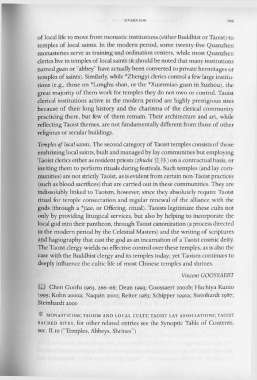Page 149 - The Encyclopedia of Taoism v1_A-L
P. 149
OVERVIEW 109
of local life to move from monastic institutions (either Buddhist or Taoist) to
temples of local saints. In the modern period, some twenty-five Quanzhen
monasteries serve as training and ordination centers, while most Quanzhen
clerics live in temples of local saints (it should be noted that many institutions
namedguan or "abbey" have actually been converted to private hermitages or
temples of saints). Similarly, while *Zhengyi clerics control a few large institu-
tions (e.g., those on *Longhu shan, or the *Xuanmiao guan in Suzhou), the
great majority of them work for temples they do not own or control. Taoist
clerical institutions active in the modern period are highly prestigious sites
because of their long history and the charisma of the clerical community
practicing there, but few of them remain. Their architecture and art, while
reflecting Taoist themes, are not fundamentally different from those of other
religious or secular buildings.
Temples of local saints. The second category of Taoist temples consists of those
enshrining local saints, built and managed by lay communities but employing
Taoist clerics either as resident priests (zhuchi tt},f) on a contractual basis, or
inviting them to perform rituals during festivals. Such temples (and lay com-
munities) are not strictly Taoist, as is evident from certain non-Taoist practices
(such as blood sacrifices) that are carried out in these communities. They are
indissolubly linked to Taoism, however, since they absolutely require Taoist
ritual for temple consecration and regular renewal of the alliance with the
gods (through a *jiao, or Offering, ritual). Taoists legitimize these cults not
only by providing liturgical services, but also by helping to incorporate the
local god into their pantheon, through Taoist canonization (a process directed
in the modern period by the Celestial Masters) and the writing of scriptures
and hagiography that cast the god as an incarnation of a Taoist cosmic deity.
The Taoist clergy wields no effective control over these temples, as is also the
case with the Buddhist clergy and its temples today; yet Taoism continues to
deeply influence the cultic life of most Chinese temples and shrines.
Vincent GOOSSAERT
III Chen Guofu 1963, 266-68; Dean 1993; Goossaert 2000b; Hachiya Kunio
1995; Kohn 2000a; aquin 2000; Reiter 1983; Schipper 199Ia; Steinhardt 1987;
Steinhardt 2000
* MONASTICISM ; TAOISM AND LOCAL CULTS; TAOIST LAY ASSOCIATIONS; TAOIST
SACRED SITES ; for other related entries see the Synoptic Table of Contents,
sec. II.IO ("Temples, Abbeys, Shrines")

